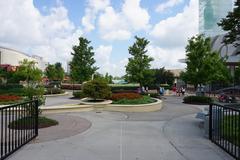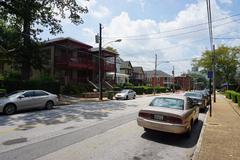Visiting Hours and Tickets for Oakland Cemetery in Atlanta
Date: 24/07/2024
Introduction
Welcome to our comprehensive guide to visiting Oakland Cemetery, a historic landmark nestled in the heart of Atlanta, Georgia. Established in 1850, Oakland Cemetery is not just a burial ground but a living museum that narrates the rich history and cultural tapestry of Atlanta. Originally known as Atlanta Graveyard, the cemetery was renamed in 1872 to reflect the beautiful oak trees that adorn its landscape (Discover Atlanta). Over the years, it has grown from a six-acre plot to a sprawling 48-acre sanctuary, thanks to multiple expansions (History Atlanta).
Oakland Cemetery is a testament to the city’s past, featuring the graves of notable figures such as Margaret Mitchell, the author of ‘Gone with the Wind,’ and Maynard Jackson, Atlanta’s first African American mayor (Atlanta on the Cheap). The cemetery also serves as a botanical oasis and an outdoor museum, with its Victorian gardens, ancient oaks, and stunning architectural elements (History Atlanta). Despite periods of neglect and vandalism, the Historic Oakland Foundation has played a crucial role in preserving this cultural gem (Oakland Cemetery).
Whether you’re a history buff, a nature lover, or looking for a unique photographic spot, Oakland Cemetery offers a myriad of experiences. This guide aims to provide you with all the essential information, from its historical significance to visitor tips, ensuring you make the most out of your visit.
Table of Contents
History of Oakland Cemetery
Founding and Early Years
Oakland Cemetery, originally known as Atlanta Graveyard or City Burial Place, was established in 1850 when Atlanta city officials purchased six acres for a city cemetery (History Atlanta). The first burial occurred shortly after the purchase, with Dr. James Nissen being the first individual interred in the cemetery. Over the years, the cemetery expanded through multiple land acquisitions, including the residence of former Atlanta Mayor James E. Williams and various nearby structures such as cotton mills. The first expansion took place in 1857, followed by additional expansions in 1864, 1866, 1867, and most recently in 2007 (History Atlanta).
Name Change and Landscape
In 1872, the cemetery was renamed Oakland Cemetery to reflect the numerous oak trees that adorned its rolling landscape (Discover Atlanta). The cemetery’s layout is a compact garden design, with faraway downtown skyscrapers echoing the opulent mausoleums and weathered headstones, making it one of the most scenic historic cemeteries in the country (History Atlanta).
Segregation and African American Burials
The history of Oakland Cemetery also reflects the racial dynamics of the Antebellum Era. In 1852, the Atlanta City Council designated a section in the eastern part of the cemetery for African American burials. By the time of the Civil War, 869 African Americans had been buried in this segregated section, all of them slaves, and nearly 60% of them children (History Atlanta). This segregation policy highlights the complex and often painful history of race relations in Atlanta.
Decline and Restoration
Throughout the 20th century, Oakland Cemetery fell into disrepair due to neglect, weather damage, and vandalism. By the mid-1970s, the cemetery, once a rural garden cemetery, found itself in the middle of one of America’s fastest-growing cities. Recognizing the need to preserve this historical landmark, Oakland Cemetery was added to the National Register of Historic Places on April 28, 1976. The Historic Oakland Foundation was subsequently created to maintain and restore the cemetery to its former glory (History Atlanta).
Notable Burials
Oakland Cemetery is the final resting place for many of Atlanta’s most noted citizens. Among the most visited graves is that of Margaret Mitchell, the author of the Pulitzer Prize-winning novel “Gone With the Wind.” Visitors can easily locate her grave using Google Maps (Atlanta on the Cheap). Another famous resident is country music star Kenny Rogers. The cemetery is also home to the grave of pro golfer Bobby Jones, whose site is a popular attraction (Atlanta on the Cheap).
Architectural and Botanical Significance
Oakland Cemetery is not just a burial ground but also a botanical oasis and an outdoor museum of Atlanta’s history. The cemetery features Victorian gardens, ancient oaks, and magnolias, as well as a variety of sculptures and architectural elements. The cemetery’s landscape includes over 1,400 trees, some nearly 200 years old, many of which reflect Victorian symbolism, such as those with a “weeping” form or tall columnar shape pointing toward heaven (Atlanta on the Cheap).
Preservation Efforts
The Historic Oakland Foundation plays a crucial role in preserving, protecting, and sharing the cemetery’s historical and cultural significance. The foundation organizes various events and tours throughout the year to engage the community and raise awareness about the importance of maintaining this historical landmark (Oakland Cemetery). One of the most popular events is the “Capturing the Spirit of Oakland” Halloween tours, an autumn tradition in Atlanta that draws enthusiasts from far and wide (Oakland Cemetery).
Visitor Experience
Guided and Self-Guided Tours
Oakland Cemetery offers a range of tours to help visitors explore its rich history and beautiful landscape. The “Sights, Symbols, and Stories” general tour is a 90-minute guided walking tour that covers the history, Victorian gardens, and art and architecture of the cemetery (Oakland Cemetery). Special topic tours are also available, focusing on specific aspects such as African American history and Victorian symbolism (Paige Minds the Gap).
For those who prefer to explore at their own pace, self-guided tours are available. Visitors can purchase a printed guide or download a self-guided tour map for a small fee (Oakland Cemetery). The cemetery also offers a self-guided dial-in tour, allowing visitors to learn about the cemetery’s history using their phones (Oakland Cemetery).
Accessibility and Amenities
Oakland Cemetery is open daily from dawn to dusk, and admission is free. The Visitor Center and Museum Store are open on weekends from 9 a.m. to 5 p.m. and on weekdays from 10 a.m. to 2 p.m. (Oakland Cemetery). Parking is available in a small lot outside the front gate, along the street on Martin Luther King, Jr. Drive, and Oakland Avenue. Due to ongoing paving projects, vehicular traffic inside the cemetery is currently restricted, but guests with limited mobility can contact the cemetery for special arrangements (Oakland Cemetery).
Community Engagement
Oakland Cemetery is not just a historical site but also a vibrant community space. It hosts various events throughout the year, including yoga and wellness sessions, night tours, and the annual “Sunday in the Park” celebration (Oakland Cemetery). The cemetery’s gardens and park-like setting make it a popular venue for weddings, picnics, and other community gatherings (Oakland Cemetery).
Ticket Prices and Opening Hours
Oakland Cemetery is open daily from dawn to dusk, and there is no admission fee. Guided tours, however, may have associated costs. For current ticket prices and to book a tour, visit the official Oakland Cemetery website (Oakland Cemetery).
Travel Tips and Nearby Attractions
When planning your visit to Oakland Cemetery, consider the following travel tips:
- Wear comfortable walking shoes as the terrain is uneven in many areas.
- Bring water, especially during warmer months.
- Check the weather forecast and dress appropriately.
Nearby attractions include the Martin Luther King Jr. National Historical Park, the Atlanta Beltline, and the Georgia State Capitol. These sites provide additional opportunities to explore Atlanta’s rich history and culture.
FAQ
Q: What are the visiting hours for Oakland Cemetery? A: Oakland Cemetery is open daily from dawn to dusk.
Q: Is there an admission fee to enter the cemetery? A: No, admission is free. However, guided tours may have associated costs.
Q: Can I take a self-guided tour? A: Yes, self-guided tours are available. You can purchase a printed guide or download a self-guided tour map for a small fee.
Q: Are there any events or tours available? A: Yes, the Historic Oakland Foundation organizes various events and tours throughout the year. Visit the official website for more details.
Q: Is Oakland Cemetery accessible to visitors with mobility issues? A: Yes, but due to ongoing paving projects, vehicular traffic inside the cemetery is currently restricted. Guests with limited mobility can contact the cemetery for special arrangements.
Conclusion
In summary, Oakland Cemetery is a treasure trove of history, architecture, and natural beauty. Its rich past, notable burials, and ongoing preservation efforts make it a must-visit destination for anyone interested in exploring Atlanta’s history. Whether you’re taking a guided tour, participating in a community event, or simply enjoying a peaceful stroll through its gardens, Oakland Cemetery offers a unique and memorable experience. Don’t forget to check the official website for updated information on visiting hours, tickets, and events. Explore more of Atlanta’s historical sites and immerse yourself in the city’s vibrant culture.











